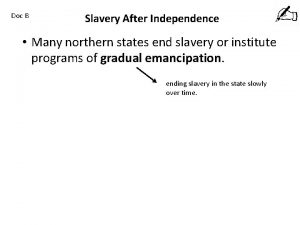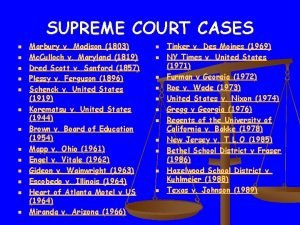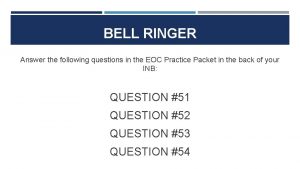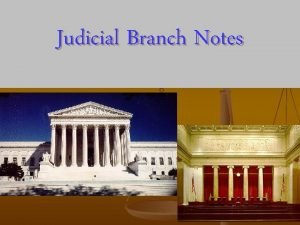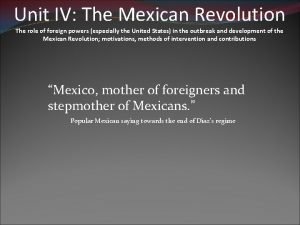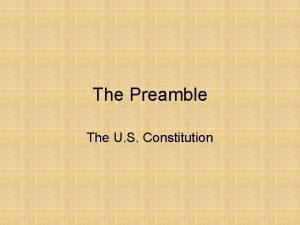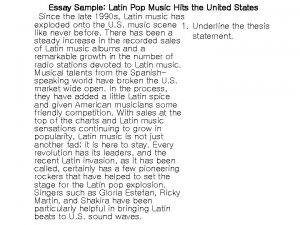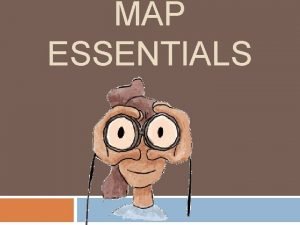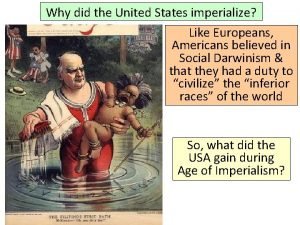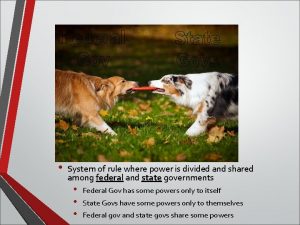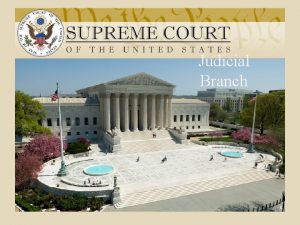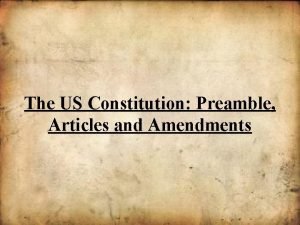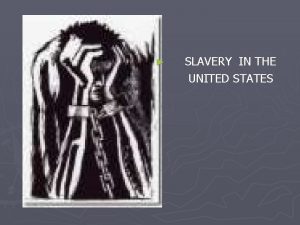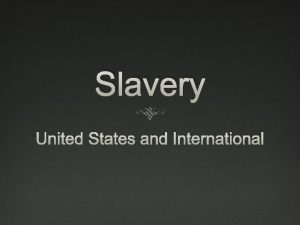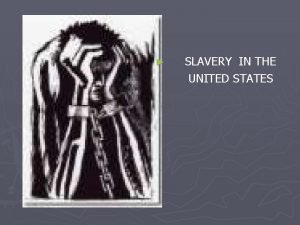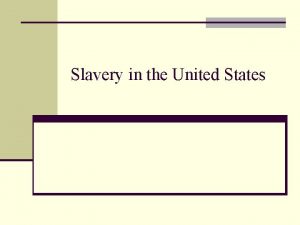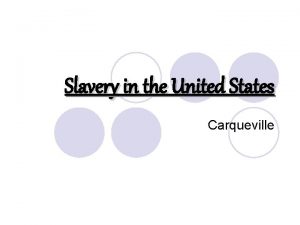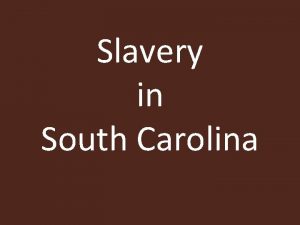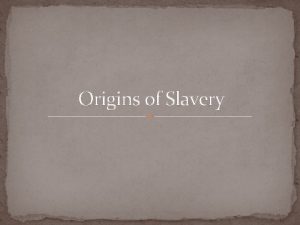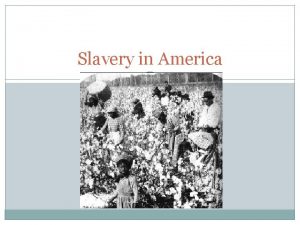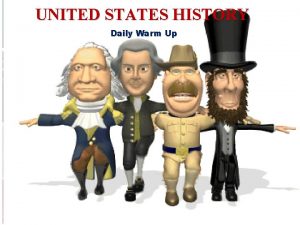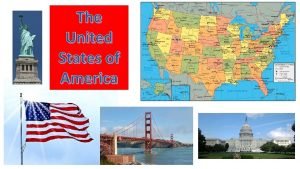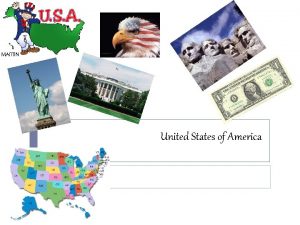Slavery in the United States Origins of Slavery






































- Slides: 38

Slavery in the United States

Origins of Slavery has existed since the beginning of recorded human history Ancient Middle Eastern world, Ancient Greece, Ancient Rome, Russia, Asia, & Africa Referred to in the Bible - condoned and accepted A fact of human history into the 20 th century.

The Genesis of Slavery in the Western Hemisphere Portuguese began exploring the African coast in the early 1400 s in search of gold. Around the mid-1400 s they developed relationships with African tribes and established the slave trade. They discovered Azores, Maderias, and Canaries in the Atlantic and began to use them as bases. Only the Canaries were inhabited (Guanche). Portuguese formed sugar plantations on these islands and used the natives as slave labor. Guanche died out in 1490 s from disease. Those who survived intermarried with Iberians, so the culture was wiped out. High death rate of Native Americans common in Western Hemisphere too Created a demand for labor

Azores and Madeiras

1492 Spanish start the institution of slavery in the Americas by importing slaves from Africa into the New World more than a century before the British found Jamestown. Spanish colonies in the Caribbean were established shortly after Columbus. The Eastern Atlantic islands proved to be the blueprint for establishing a lucrative sugar plantation economy.

Jamaican Sugar Plantation

Labor Source Labor is a desperately needed resource New continent opened with no mechanization Needed manpower to open up the continent to be conquered People Could use Europeans or Native Americans, but they were limited in numbers. A cheap and available source would be African slaves

Slave Trade Europeans could not go into the African interior Local tribes traded along the West coast of Africa: African slave traders would sell people for rum, guns, and other manufactured goods Slaves were relatively cheap at the time Profits were high Not simply a Spanish enterprise. Eventually the English, French and Dutch became involved in the slave trade

Lifecycle of the Slave Trade: Africans in neighboring tribes might be captured in battle or in a village raid African raiders marched their captives to the coast in long lines known as coffles. They were yoked together by the neck. Some marches exceeded 500 miles. Portuguese had constructed slave fortresses along African coast to protect their industry Captives were herded into pens called barracoons. They were stripped and examined. Only the reasonably healthy were taken. Once purchased, the traders branded the slave.

Coffles and Barracoon Coffles Barracoon

Lifecycle of the Slave Trade: The Middle Passage Slaves were then ferried to ships in the harbor. Ship holds would be crammed over capacity. The Middle Passage - The voyage from Africa to the Western Hemisphere The shortest route with good winds could be a three week trip. But the unpredictable equatorial winds could strand a ship for weeks if the wind was dead. If this happened, slavers would throw slaves overboard to make provisions last. Africans were forced to live below decks most of the time, crammed into cargo holds Forced to live in their own waste and vomit About 20% of slaves died on the middle passage.

Hold of a Slave Ship

Lifecycle of the Slave Trade: The Americas Upon arrival: Ship captains cleaned, shaved, and greased slaves with palm oil to make them appear healthy. Captains conducted sales Invited buyers on board Held auctions on shore

Advertisement for a Slave Sale - 1769

Slavery in North America Slavery and race in Southern United States were synonymous. Free blacks in the south are viewed as an anachronism (out of place for its time) Synonymous in terms of the legal system and white attitudes. They aren’t built into the legal system. They are tolerated but most viewed them as people who should be slaves simply because they were black. This is uniquely American It is true that Central and South America had large black slave populations, but they also had a large free black population with citizenship rights

British Slavery Once the British establish themselves in North America, British colonists create plantation economies throughout the South. Tobacco in the Chesapeake Indigo and rice in the Carolinas Sugar in Louisiana And later, cotton in the Deep South.

A System of Racial Control: Early Years Prior to 1670, there were no legal codes that prohibited rights to slaves. There were too few African Americans They could purchase their freedom They could acquire their own property Dozens of slaves at this time bought and sold property and purchased their freedom and started their own common farm. They could marry, move about freely, carry firearms, baptize their children, testify in court, and vote Interracial marriage existed Anthony Johnson – freed slave Purchased a 250 acre tobacco plantation, owned a slave, sued a neighbor for theft of property and won the case

A System of Racial Control: 1660 s & on As more slaves enter the country Fear uprisings Slave codes Cheaper form of labor So… In the 1660 -80 start to assign the term “forever” to the terms and conditions regarding length of service. Legal definition of slavery early on is pretty fuzzy Slavery is now a permanent thing.

System of Racial Control: Social Impact Important socially in the tiers of white society. Help define a class system Bottom class of white society Higher on the social ladder Do not compete with African-Americans for jobs

Decline of Slavery (1776 -1790 s) Plantation Issues Moral reasons to eradicate slavery surfaced Tobacco – soil tapped Rice - limited Sugar & Rice - large capital investments for machinery After the Revolution - protected markets in England disappeared Declaration of Independence Steps taken to abolish the foreign slave trade Northern states begin to abolish slavery in the late 1700 s 1777 – Vermont – new Constitution prohibited slavery 1789 – Massachusetts – used interpretation of rights to outlaw slavery 1780 – Pennsylvania – Gradual Emancipation Act – all persons born after Mar 1, 1780 were to be free at 28 yrs old. Manumission Laws – southern people can emancipate their slaves if they wish. Weren’t that many slaves in country in 1790 (700, 000) – made abolition easier to consider

Reflections of Slavery After 1790, there is a growing critique of slavery. New republic and many begin to say slavery has no place in a republic. It’s unchristian, immoral, and not democratic – goes against the country we are trying to create. This sentiment is championed by the abolitionist movement in the North in the early to mid 1800 s.

The Growth of Slavery from 1791 to 1860 “King Cotton” & invention of Cotton Gin (1791) created renewed demand for slaves Growing cotton now profitable Indian Removal Act 1830 cleared land Cultivation of cotton was well-suited to slavery Large number of unskilled laborers required Work was tedious and difficult, but didn’t require great strength, so women and children could do it You could work into your 50 s and 60 s Grows low to the ground, so 1 or 2 people could supervise many slaves

Cotton Gin

King Cotton becomes dominant crop in south after 1800, particularly in 1830 -60 Cotton exports: 17. 5 million bales in 1815 29 million bales by 1830 192 million bales by 1860 Demand for slaves in Deep South increases with cotton production: 700, 000 slaves by 1790 By 1830 - 2 million slaves By 1860 – 4 million slaves

Meeting the Increasing Demand for Slaves The Illegal Foreign Slave Trade Federal law after 1808 bans the slave trade Illegal Slave Trade Profitable Estimated 200, 000 – 300, 000 slaves brought in. Natural methods Young women were encouraged to have children (forced and pressured) Had 10 -12 -14 children The Legal Domestic Slave Trade Most slaves in 1790 were in Maryland, Virginia, South Carolina and Georgia Migration of slaves from the upper South to the lower South Upper South planters sold excess slaves to slave trade companies who would sell them to plantation owners in the Deep South New Orleans was the center of this market. Prices were high

Domestic Slave Trade – Atlanta, Ga 1864

Southern Justifications for Slavery Bible Old Testament/Jesus did not condemn slavery Southern Honorable Society Treated slaves with respect Southerners are aristocrats: honor was a big part of their society George Fitzhugh said…Yankee society is corrupt and morally bankrupt…they are the true exploiters of people. Southerners are taking inferior people and protecting, feeding them White Superiority – African Americans are inferior Prior to the 1830 s, Southerners were not proud of slavery as a whole, but deemed it a necessary evil. Later with the rise of abolitionists, this attitude would change and slavery would be described as a positive good.

The World of the Slave Floggings/whippings were common forms of punishment The Family Had a very strong attachment to the family Slaves could be separated at whim of the master since slaves couldn’t have a legal marriage. Women were at the mercy of the master and could be sexually abused without recourse. The sense of family was under attack by the institution of slavery

Master’s Attitude Toward Slavery is an economic proposition. The harder slaves work, the more production the master gets. He tries to keep morale at as high a level as possible How does the master maintain morale? Devise work competitions Fire cruel overseers Appoint excellent workers as the Driver - better work, better living conditions Don’t break families Masters shouldn’t sleep with slaves

Scars from Whip Lashings “Overseer Aarayou Carrier whipped me. I was two months in bed sore from the whipping. My master come after I was whipped; he discharged the overseer”

Slave Religion, Music and Literature Religion was a strong force. Combination of African and protestant faiths Certain things in Bible appealed to the slaves. Identified with the Israelites in Egypt and believed in Salvation. After life will be better than life on Earth. Music is reflected in primarily gospel music and folk music yearning for freedom.

Resistance If slaves obeyed and appeared to be satisfied, their existence would be better. There ways to challenge the system without seeming unsatisfied. Southerners felt African-Americans were naturally lazy, so a work slow-down wouldn’t seem out of line, but would be a way to buck the system. Slow the system down by feigning sickness or injury Breaking, losing tools Arson

Fugitive Slaves Escapes Not sure of the number of attempts or successful escapes Abolitionists claim that all slaves yearn for freedom and constantly slaves attempting to escape – this is one point of view Slave Owners denied this… said if slaves are well-treated, well-fed, and not subject to manipulation, they will not run away If you look at southern newspapers between 1815 -1860 there would be a fair number of advertisements to capture and return runaway slaves Tried to make it to a free state. Used the underground railroad.

Slave Rebellions 1700 – 1860 – very few uprisings happened 1790 – Haitian Rebellion – insurgents overthrow the Haitian government on the island. Aug 1831 – Southampton Cty, Va - Nat Turner’s Rebellion This was confirmation to many Northerners that slaves wanted their freedom. Sharp clamp down on slavery after this. After 1831 there is not another debate about slavery in the south. The south becomes more of a closed society to keep out dissenting positions. If you did oppose slavery in the south and discussed it, you could be run out of town.

Nat Turner Rebellion

Free African Americans in the South They had a difficult existence There were free black communities in southern cities. Free black middle classes – business owners (services) Black schools

In the North Not treated much better in the north. In bigger cities there are sizable black communities Emergence of black businesses, churches, middle class, educational institutions – segregated in these institutions as well as public facilities. Discriminated against for employment

Conclusion Southern societal and labor needs maintained the institution of slavery in America Attitudes towards African-American slaves declined over time Segments of northern society tried to eliminate slavery, however Northern society also discriminated against African-Americans
 Was tennessee a slave state
Was tennessee a slave state Gender empowerment measure
Gender empowerment measure Mapp v. ohio
Mapp v. ohio The physical geography of the united states and canada
The physical geography of the united states and canada How did these events affect the united states
How did these events affect the united states Reporter ffa symbol
Reporter ffa symbol Judicial branch
Judicial branch What the united states has fought for
What the united states has fought for Awake united states
Awake united states Plessy v ferguson summary
Plessy v ferguson summary President help wanted poster
President help wanted poster Perceptual regions of the united states
Perceptual regions of the united states The united states ought to provide a universal basic income
The united states ought to provide a universal basic income Kentucky primary care association
Kentucky primary care association 7 regions of the united states
7 regions of the united states Activity 2 let's review
Activity 2 let's review Chapter 5 lesson 1 physical geography of the united states
Chapter 5 lesson 1 physical geography of the united states Howland island
Howland island Uscdi
Uscdi Usa map latitude longitude
Usa map latitude longitude United states v. cruikshank apush
United states v. cruikshank apush Preamble
Preamble Expansion of the united states of america 1607 to 1853 map
Expansion of the united states of america 1607 to 1853 map United states government: principles in practice
United states government: principles in practice Latin music essay
Latin music essay Usa pro soccer
Usa pro soccer Hawks and doves vietnam
Hawks and doves vietnam Earth latitude map
Earth latitude map United states
United states Booklet aiesec
Booklet aiesec Why did the united states invade cuba in 1898?
Why did the united states invade cuba in 1898? Why did the united states imperialize
Why did the united states imperialize United states v lopez commerce clause
United states v lopez commerce clause Alabama alaska arizona arkansas
Alabama alaska arizona arkansas Chapter 5 section 1 landforms and resources
Chapter 5 section 1 landforms and resources East of the mississippi river
East of the mississippi river United states judicial branch
United states judicial branch What is the origin of clowns
What is the origin of clowns The preamble of the constitution
The preamble of the constitution
